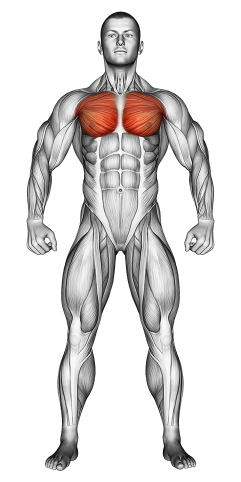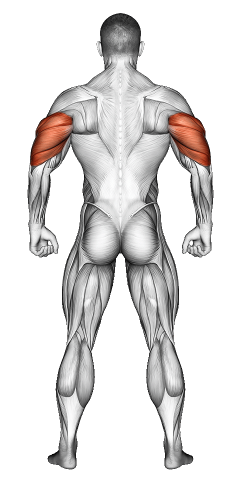Cable Cross Over: Video Tutorial & Exercise Guide

Written By: Claude Michael
Updated: Oct 13, 2024
| Workout | Cable Cross Over |
| Primary Muscle Group | Chest |
| Secondary Muscle Group | Shoulders, Triceps |
| Equipment Required | Cable |
| Force Type | Pull |
| Mechanics | Isolation |
| Exercise Type | Strength |
| Difficulty | Intermediate |
Cable Cross Over: Video Tutorial & Exercise Guide
- 1.Cable Cross Over: Muscle Groups
- -1.1Primary Muscle Group
- -1.2Secondary Muscle Group
- 2.Cable Cross Over: Step-by-Step Guide
- 3.Cable Cross Over: Overview
- 4.Cable Cross Over: Benefits
- 5.Cable Cross Over: Pro Tips & Advanced Techniques
- 6.Cable Cross Over: Progression Plan
- 7.Cable Cross Over: Frequently Asked Questions (FAQs)
Cable Crossover: Step-by-Step Guide
- Step 1: Set the pulleys on a cable machine to their highest position. Stand between the two cable stacks and grab the handles with an overhand grip, palms facing down.
- Step 2: Step forward, pulling the handles with you, and position one foot slightly ahead of the other for stability. Lean slightly forward from your hips, keeping your back straight and your core engaged.
- Step 3: Start with your arms extended out to your sides, elbows slightly bent. This is your starting position.
- Step 4: Bring the handles togClaude in a wide arc in front of your body, crossing your hands over slightly as they meet in the middle. Focus on squeezing your chest muscles at the end of the movement.
- Step 5: Slowly return to the starting position, keeping tension on your chest throughout the movement. Avoid letting the weights pull your arms back too quickly.
Cable Crossover: Overview
The Cable Crossover is an isolation exercise that primarily targets the pectoral muscles. It is one of the best movements for developing the inner and lower chest while also improving the overall shape and definition of the chest muscles. The use of the cable machine provides constant tension throughout the entire range of motion, maximizing muscle engagement.
This exercise is ideal for those looking to enhance the aesthetics of their chest, as well as athletes aiming to build functional strength. It’s a staple in most upper-body routines due to its versatility and effectiveness.
Cable Crossover: Benefits
Cable Crossovers help to build a fuller, more defined chest by targeting the inner and lower pectoral muscles. The constant tension provided by the cables ensures that the muscles remain engaged throughout the movement, leading to better muscle activation and growth.
Additionally, this exercise improves shoulder stability and coordination, making it a great addition to any upper-body workout. It also allows for a more controlled and isolated chest workout compared to free weights.
Cable Crossover: Pro Tips & Advanced Techniques
Focus on controlling the movement, especially during the negative (eccentric) phase, to increase time under tension. Avoid using momentum or letting the cables pull your arms back too quickly. For added intensity, pause at the end of the movement and squeeze your chest muscles before slowly returning to the starting position. To target different parts of the chest, adjust the pulley height—lower pulleys focus on the upper chest, while higher pulleys emphasize the lower chest.
Cable Crossover: Progression Plan
Beginner
Intermediate
Advanced
Cable Crossovers: Frequently Asked Questions (FAQs)
What muscles do Cable Crossovers target?
+Cable Crossovers primarily target the pectoral muscles, with an emphasis on the inner and lower chest. They also engage the shoulders and triceps to a lesser extent for stability.
How can I make Cable Crossovers easier?
+To make the exercise easier, use lighter weights and focus on controlling the movement throughout the range of motion. You can also limit the range of motion until you’re more comfortable with the movement.
How do I increase the difficulty of Cable Crossovers?
+To increase the difficulty, use heavier weights or slow down the movement to increase time under tension. You can also try adding a pause and squeeze at the peak contraction point for greater muscle activation.
How often should I do Cable Crossovers?
+Incorporate Cable Crossovers 1-2 times per week as part of your chest or upper-body workout routine. They pair well with pressing movements like bench presses for a well-rounded chest workout.
What common mistakes should I avoid?
+Avoid letting the weights pull your arms back too quickly or using excessive momentum. Focus on slow, controlled reps and maintaining constant tension on your chest muscles throughout the exercise.
Share
Don’t Wish for It, Work for It – Join the FlexXP Newsletter Today!
Thank you for signing up for the FlexXP Newsletter!
This site is protected and the Google Privacy Policy and Terms of Service apply.


